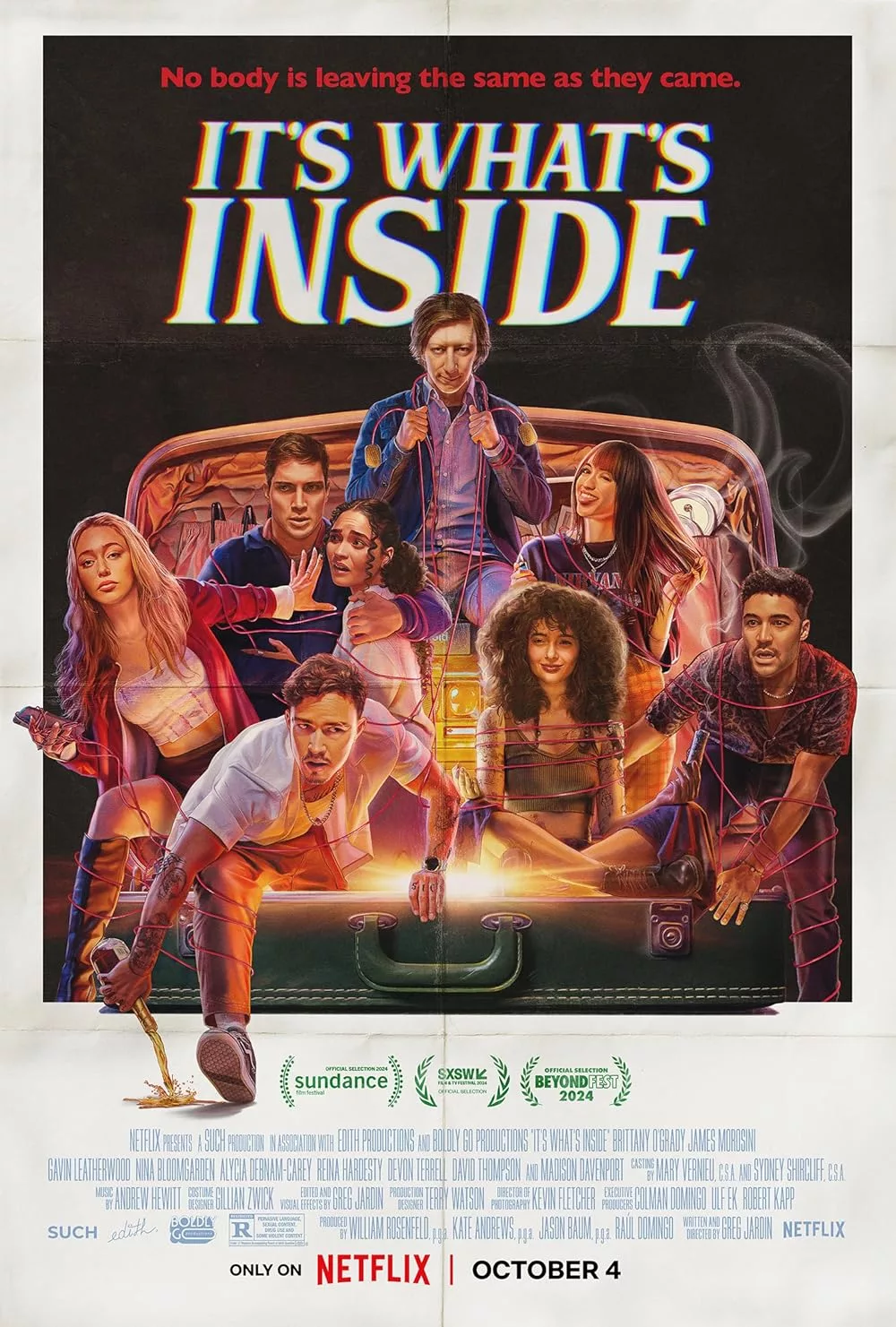Precarious game nights have become common fodder for horror film fun, with "Bodies Bodies Bodies" and "Talk To Me" being two of the biggest hits out of the genre this decade so far. Writer-director Greg Jardin digs into this format for his feature debut, "It's What's Inside," now on Netflix.
Cyrus (James Morosini) and Shelby (Brittany O'Grady) are having relationship problems. They've been together nearly a decade, and with no ring and no sex, their day-to-day interactions are fraught and unfulfilling. Adding insult to injury, with the wedding of their college friend Reuben (Devon Terrell) days away, they hit the road to his late mother's estate, where they will be reunited with their old friend group for a bash before his wedding.
They meet up with the other members of their university clique: edgy stoner Brooke (Reina Hardesty), bro-y party boy Dennis (Gavin Leatherwood), newly Buddhist spiritual hippie Maya (Nina Bloomgarden), and influencer Nikki (Alycia Debnam-Carey), who is the object of Cyrus' latent desire and Shelby's visceral envy. As the group wonders whether their other friend Forbes (David Thompson), with whom they have a dicey relationship due to their influence on his expulsion from the college, will show up, he appears at the back window, mysterious briefcase in hand.
Working in the field of high technology, the suitcase contains a machine he proposes they use for a game. By connecting electrodes to the temples of all in the room, with the flip of a switch, everyone switches bodies. The game is to figure out who is now possessing whose body. It's a tripped-out version of Mafia (also known as Werewolf) that the crew abuse to live out their desires, envies, and vendettas.
Narratively, it's quite difficult not to notice the pointed similarities to the aforementioned "Bodies Bodies Bodies." From the lavish estate to the somewhat-estranged friend and remixed game of Mafia, it's almost too close for comfort. Even the satire on friend groups is similar, though where the former delivers mockery on Gen-Z, "It's What's Inside" caters to an older, more millennial audience through its discourse on long-term relationships and personal fulfillment.
"It's What's Inside" is a comedy with a gentle sprinkling of horror elements. As bodies trade off and the characters explore what they can do anonymously or find newfound confidence in the objects of their envy, Jardin only scratches the surface on his format's horrifying and existential capacity. With the film's concept allowing for so much play, it could've armed itself with fast and loose narrative weaponry to boost the stakes and fun to a bloody, lusty high. Instead, "It's What's Inside" opts for safety.
What does work is Jardin's humorous pen. The film's cast of characters is fun to laugh at (and with), as the situational comedy of their mixed bag of personalities leaves plenty of room for clashes. Even as the characters fit into archetypal roles, they're stereotypes with which we can identify and recall people in our own lives. The film excellently captures the uneasy feeling of a former friend group reuniting. All the joy of memory lane comes back, but with it creeps the recollection of disagreements and Band-Aids of wounds that no longer stick to the skin. When college is over and life moves on, the people we become away from the context and identity of school can be so divergent that it's hard to find the throughline that once existed. What's most potent are the whispers of emotions of the late teens-early 20s versions of ourselves that rise to a roar in the presence of those who knew us, and "It's What's Inside" places this in the forefront of its storytelling.
Jardin employs a punchy style in his filmmaking, using split screens and lively neon colors as tools for identification. These elements, along with a witty flashback sequence in the form of constantly changing photographs, add to the nostalgia that keeps the film's existential implications in orbit while perfectly depicting what it feels like to be in a drunken gossip session about times past.
With different personalities shifting into the same bodies, there's ripe opportunity for unique, diverse performances from the actors as they trade characters. Thompson, when playing his true character, Forbes, is pointedly and cartoonishly strange in demeanor but in a way that feels self-aware. Through his early introduction in the film, he's the one who sets the tone equally as his character puts the film's events into motion.
Mostly, the ensemble cast prioritizes maintaining the levity of Jardin's script, but Morosini and Debnam-Carey are the standouts. Debnam-Carey goes from a hollow, comedic vanity to a deeply emotional and insecure place with nuance, having one scene in the latter third that blindsides you with emotion in what's mostly been a comedic narrative ride. Morosini's ambivalence turned obnoxiousness delivers a great amount of humor in the final act as well, and he's the one who keeps the energy up as the story takes a slower turn towards its conclusion.
Sadly, the film's ending feels displaced in tone and emotional believability, not coming across as entirely earned, and its pacing feels like a dead stop compared to what Jardin had previously established. "It's What's Inside" is a fun jaunt through the dynamics of a friend group and the interiorities of its members, even as it sanitizes its potential.
Now on Netflix.


















